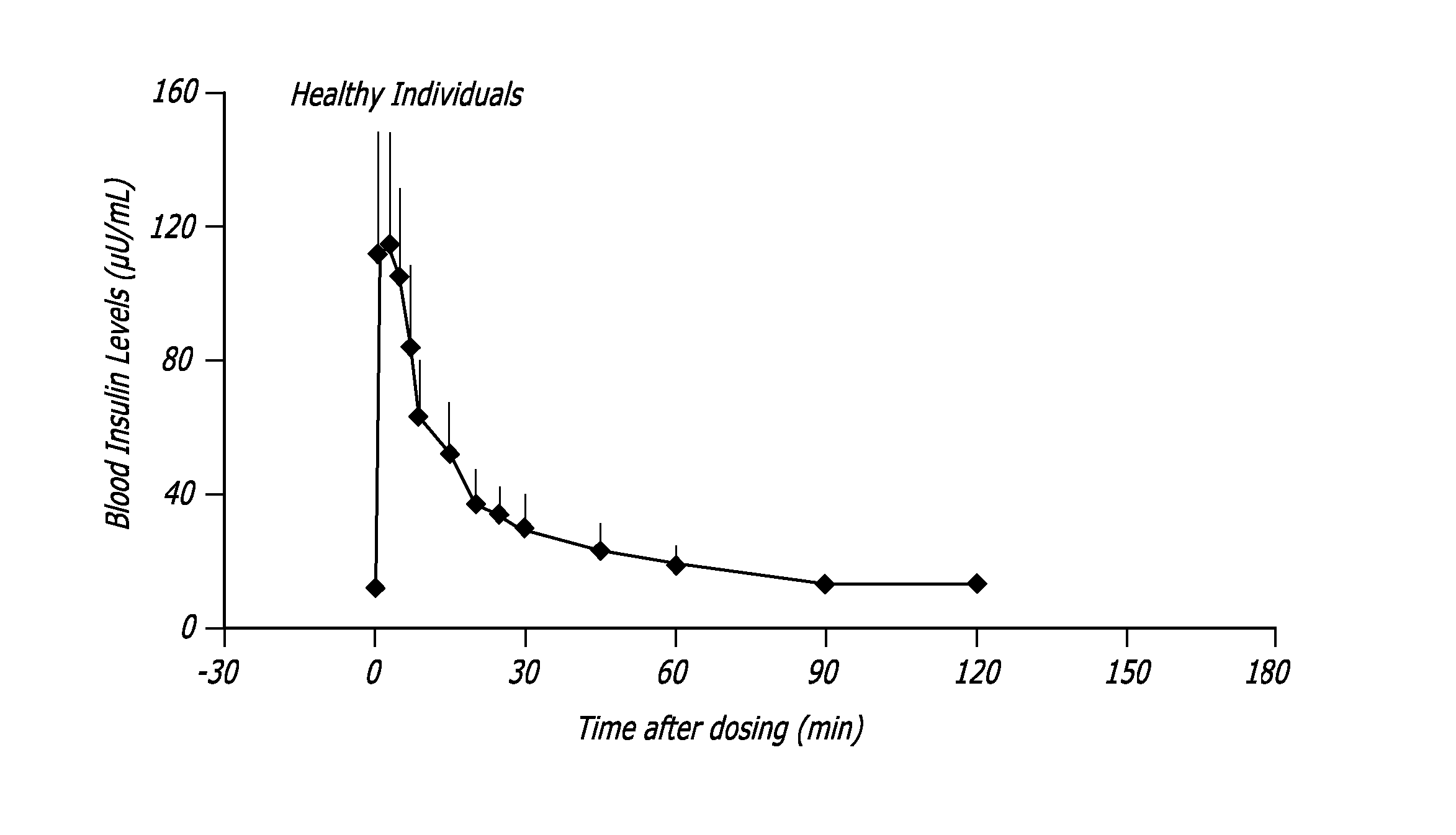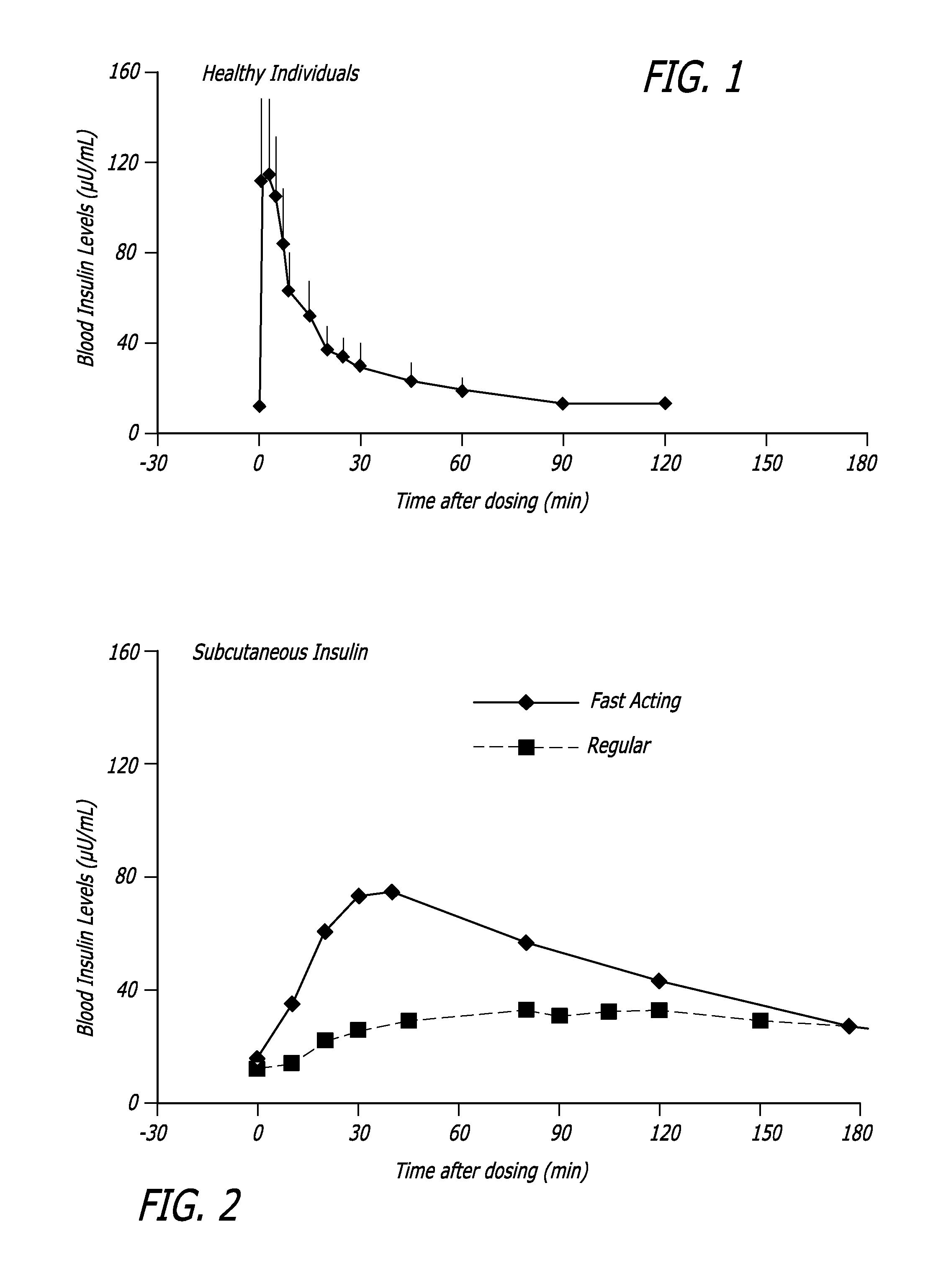Method of preserving the function of insulin-producing cells
a technology of insulin-producing cells and function, which is applied in the field of preservation of can solve the problems of prolonged elevated blood glucose levels, affecting the function of insulin-producing cells, and generating sluggish responses, so as to reduce the serum level of proinsulin, prolong the lifespan of insulin-producing cells, and improve the effect of insulin-producing cells
- Summary
- Abstract
- Description
- Claims
- Application Information
AI Technical Summary
Benefits of technology
Problems solved by technology
Method used
Image
Examples
example 1
A Randomized, Double-Blind, Placebo Controlled Study of the Efficacy and Safety of Inhaled TECHNOSPHERE® / Insulin in Patients with Type 2 Diabetes
[0095] TECHNOSPHERE® dry powder, pulmonary insulin delivered via a small pulmonary inhaler has a bioavailability that mimics normal, meal-related, first- or early-phase insulin release. This multicenter, randomized, double-blind, placebo-controlled study was conducted in type 2 diabetes mellitus patients inadequately controlled on diet or oral agent therapy (HbA1c>6.5% to 10.5%). A total of 123 patients were enrolled and 119, the intention-to-treat population (ITT), were randomized in a 1:1 ration to receive prandial inhaled TECHNOSPHERE® / Insulin from unit dose cartridges containing between 6 to 48 units of human insulin (rDNA origin) or inhaled TECHNOSPHERE® / placebo (PBO).
[0096] Glycosylated hemoglobin A1c (HbA1c) results were analyzed by a predetermined statistical analysis plan for the Primary Efficacy Population (PEP, defined prior t...
example 2
Mimicry of the Early Phase Insulin Response in Humans with Rapidly Bioavailable Inhaled Insulin Accelerates Post Prandial Glucose Disposal Compared to Insulin with Slower Bioavailability
[0098] The relationship between time, insulin concentration, and glucose elimination rate in a group of 12 subjects with type 2 diabetes, during an isoglycemic clamp was studied. Each subject received 24 IU (International Units) subcutaneous insulin (Actrapid®, Novo Nordisk) or 48 U TECHNOSPHERE® / Insulin (TI, MannKind Corporation)) on separate study days in a cross-over design. Glucose Elimination Rate (GIR) was determined by the amount of glucose infusion required to maintain stable blood glucose of 120 mg / dL during the 540 minute study period (FIG. 3).
[0099] Forty-eight units TI provided a mean maximum concentration of insulin (Cmax) of 114.8±44.1 (mean±SD) mU / L and had a median time to maximum concentration (Tmax) of 15 min, whereas 24 IU subcutaneous insulin (SC) had a Cmax of 63±10.1 mU / L wit...
example 3
Treatment of Humans with Pulmonary Insulin Reduces Serum Proinsulin Levels
[0103] Inhalation of TECHNOSPHERE® / Insulin (TI) provides a rise in serum insulin, comparable to the first phase response. This study investigated the pharmacodynamics of TI and its impact on intact proinsulin (iPi) release. Twenty-four patients with Type 2 diabetes received doses of TECHNOSPHERE® base with 4 different loadings of insulin, either 0, 12 IU, 24 IU, or 48 IU of recombinant regular human insulin, five minutes after the start of standardized meals, on separate study days. Blood glucose (BG), serum insulin and serum iPi were measured before (0 min), 60 and 120 min after initiation of each meal.
[0104] TI lowered postprandial BG levels in a dose-dependent manner. Sixty minutes after lunch, BG (mg / dL) (±SD) was 183.2 (±44.4) for placebo; 170.8 (±30.5) for 12 IU (p=0.266); 156.3 (±31.9) for 24 IU, (p=0.020) and 132.6 (±29.1) for 48 IU, (p<0.001). All doses caused an increase in serum insulin at 60 min...
PUM
| Property | Measurement | Unit |
|---|---|---|
| concentration | aaaaa | aaaaa |
| concentration | aaaaa | aaaaa |
| concentration | aaaaa | aaaaa |
Abstract
Description
Claims
Application Information
 Login to View More
Login to View More - R&D
- Intellectual Property
- Life Sciences
- Materials
- Tech Scout
- Unparalleled Data Quality
- Higher Quality Content
- 60% Fewer Hallucinations
Browse by: Latest US Patents, China's latest patents, Technical Efficacy Thesaurus, Application Domain, Technology Topic, Popular Technical Reports.
© 2025 PatSnap. All rights reserved.Legal|Privacy policy|Modern Slavery Act Transparency Statement|Sitemap|About US| Contact US: help@patsnap.com



